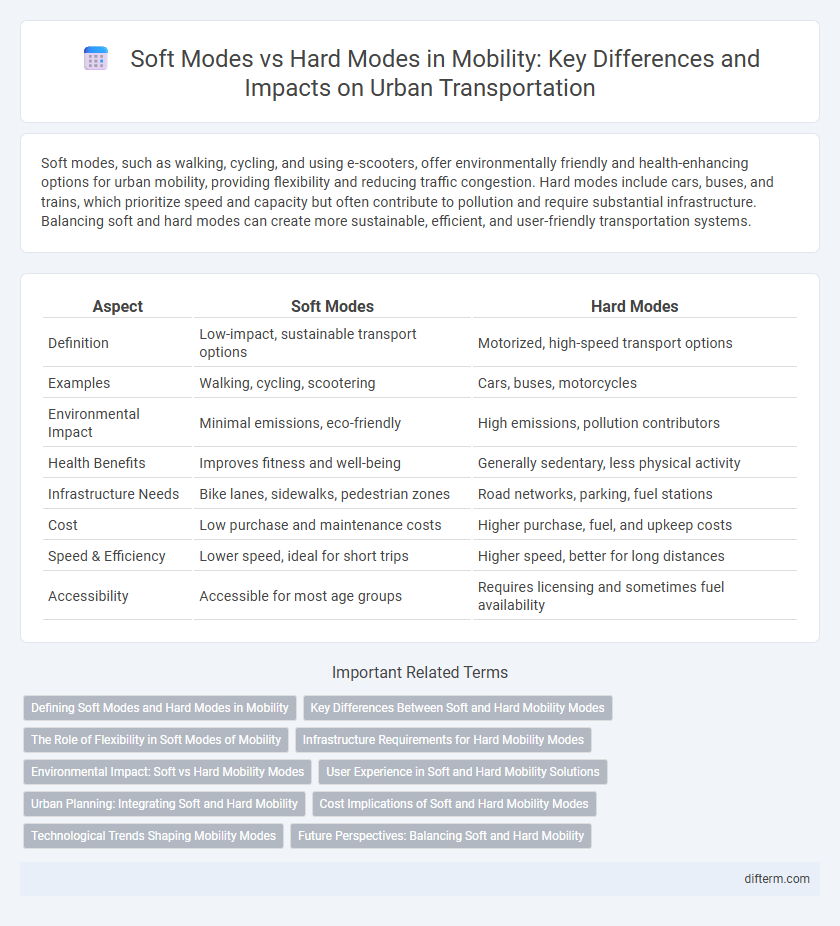Soft modes, such as walking, cycling, and using e-scooters, offer environmentally friendly and health-enhancing options for urban mobility, providing flexibility and reducing traffic congestion. Hard modes include cars, buses, and trains, which prioritize speed and capacity but often contribute to pollution and require substantial infrastructure. Balancing soft and hard modes can create more sustainable, efficient, and user-friendly transportation systems.
Table of Comparison
| Aspect | Soft Modes | Hard Modes |
|---|---|---|
| Definition | Low-impact, sustainable transport options | Motorized, high-speed transport options |
| Examples | Walking, cycling, scootering | Cars, buses, motorcycles |
| Environmental Impact | Minimal emissions, eco-friendly | High emissions, pollution contributors |
| Health Benefits | Improves fitness and well-being | Generally sedentary, less physical activity |
| Infrastructure Needs | Bike lanes, sidewalks, pedestrian zones | Road networks, parking, fuel stations |
| Cost | Low purchase and maintenance costs | Higher purchase, fuel, and upkeep costs |
| Speed & Efficiency | Lower speed, ideal for short trips | Higher speed, better for long distances |
| Accessibility | Accessible for most age groups | Requires licensing and sometimes fuel availability |
Defining Soft Modes and Hard Modes in Mobility
Soft modes in mobility refer to non-motorized and low-impact transportation options such as walking, cycling, and e-scooters, which promote sustainability and reduce traffic congestion. Hard modes encompass motorized, mechanized transport like cars, buses, and trains, characterized by higher speed, capacity, and infrastructure requirements. Understanding the distinction between soft and hard modes is crucial for urban planning aimed at balancing efficiency, environmental impact, and public health.
Key Differences Between Soft and Hard Mobility Modes
Soft mobility modes, such as walking, cycling, and using public transportation, emphasize sustainability, reduced carbon emissions, and health benefits by encouraging active travel. Hard mobility modes include private vehicles, motorcycles, and taxis, which rely on fossil fuels, contribute significantly to traffic congestion, and have higher environmental impacts. Key differences lie in infrastructure requirements, environmental footprint, and user cost, with soft modes promoting urban livability and hard modes offering speed and convenience at greater ecological and social costs.
The Role of Flexibility in Soft Modes of Mobility
Flexibility plays a crucial role in soft modes of mobility such as walking, cycling, and public transit by allowing users to adapt routes and schedules based on real-time conditions and personal preferences. Soft modes emphasize multimodal integration and accessibility, facilitating seamless transitions between different transportation methods while reducing reliance on rigid infrastructure. Enhanced flexibility in these systems promotes sustainability, reduces congestion, and improves overall urban mobility efficiency.
Infrastructure Requirements for Hard Mobility Modes
Hard mobility modes such as private vehicles, buses, and trains demand extensive infrastructure investments including paved roads, rail networks, bridges, tunnels, and parking facilities. These infrastructures require substantial land use, regular maintenance, and significant capital expenditure to ensure safety, efficiency, and capacity for high-speed or heavy-load transportation. Compared to soft modes like walking and cycling, hard modes impose more complex planning challenges and longer implementation timelines due to their larger structural and technological requirements.
Environmental Impact: Soft vs Hard Mobility Modes
Soft mobility modes such as walking, cycling, and electric scooters produce significantly lower greenhouse gas emissions compared to hard mobility modes like cars, buses, and trains. Soft modes contribute to reduced air pollution, lower noise levels, and minimized urban heat effects, promoting healthier and more sustainable city environments. In contrast, hard mobility modes heavily depend on fossil fuels and infrastructure, leading to substantial environmental degradation and higher carbon footprints.
User Experience in Soft and Hard Mobility Solutions
User experience in soft mobility solutions such as walking, cycling, and e-scooters prioritizes comfort, flexibility, and environmental impact, offering personalized and accessible transport options. Hard mobility solutions like cars, buses, and trains emphasize speed, capacity, and infrastructure reliability, often optimizing for efficiency and safety in mass transit. Integrating soft and hard modes enhances urban mobility by balancing convenience with sustainability, improving overall user satisfaction across different transportation needs.
Urban Planning: Integrating Soft and Hard Mobility
Urban planning integrating soft modes like walking and cycling with hard modes such as cars and public transit enhances sustainable mobility by reducing congestion and emissions. Designing compact, mixed-use neighborhoods supports soft mobility, while efficient public transport infrastructure ensures seamless connectivity. This balanced approach improves urban livability and encourages a modal shift towards eco-friendly transportation options.
Cost Implications of Soft and Hard Mobility Modes
Soft mobility modes such as walking, cycling, and e-scooters present significantly lower infrastructure and maintenance costs compared to hard mobility modes like cars, buses, and trains. While soft modes require investments in pedestrian pathways and bike lanes, hard modes demand extensive capital for roads, fuel, vehicle maintenance, and complex transit systems. This cost differential highlights the economic efficiency and sustainability advantages of promoting soft mobility in urban planning.
Technological Trends Shaping Mobility Modes
Soft modes like walking and cycling are increasingly integrated with digital technologies such as smart wearables and mobile apps to enhance user experience and safety. Hard modes including electric vehicles and autonomous cars leverage advancements in AI, battery technology, and IoT connectivity to improve efficiency and reduce environmental impact. Emerging trends emphasize multimodal transport systems, combining soft and hard modes through seamless technology-driven platforms to optimize urban mobility.
Future Perspectives: Balancing Soft and Hard Mobility
Future urban mobility demands an integrated approach balancing soft modes such as walking and cycling with hard modes including electric vehicles and public transport systems. Emphasizing sustainable infrastructure, smart planning, and digital connectivity enhances the efficiency and environmental benefits of both mobility types. Innovations in multimodal transport platforms and policy frameworks promote seamless, low-emission travel and improved urban accessibility.
soft modes vs hard modes Infographic

 difterm.com
difterm.com